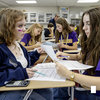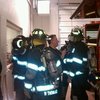Voorheesville gets more info on school reopening
NEW SCOTLAND — For the past week, the Voorheesville Central School District has been engaged in an open dialogue with the community regarding reopening school this fall.
Beginning last Thursday, the district put out more information about reopening. On Monday, the school board held a two-hour special meeting to discuss those particulars. And on Wednesday, separate forums were held for students and their parents to update each group on the district’s reopening plan.
Included among district’s 50-point overview reopening plan are that:
— The official start date of school may be shifted;
— Students and staff are to wear “face coverings consistently,” except “when engaged in instruction and seated at a desk that is physically distant from peers and staff”;
— Parents will be asked to take their child’s temperature daily;
— There will be daily health screenings for staff and students;
— Students and staff are to be trained on proper hand and respiratory hygiene as well as on proper face-covering practices; and
— There are to be daily cleaning and disinfecting protocols
Under the current plan, kindergarten through sixth grade classes would be in-person every day, while students in seventh, eighth, ninth, 10th, 11th, and 12th grades would come into school one day a week — with seventh- and ninth-graders coming in on the same day, so that the students can be on a five-day rotation; the other days, the students would be learning remotely.
But the district is constantly looking at how it can get students more in-person instruction.
On Tuesday, Superintendent Frank Macri told The Enterprise that Voorheesville is also examining if it’s possible to have two grades of seven through 12 come for on-site learning, so students would be on a three-day in-class rotation.
Also made clear in Thursday’s update, and reiterated during Monday’s school board meeting, was that the reopening plan was “staffing dependent” and “subject to change based on availability of staff and funding.”
Additional staff will have to be hired to supervise students in socially-distanced classrooms. As for any additional funding to help do that, unless Congress passes a new coronavirus stimulus bill, Voorheesville’s $26 million budget for the 2020-21 school year is set. “It’s done; we can’t overexpend,” Macri said.
The coronavirus stimulus bill that passed in late March earmarked $30.7 billion for education spending, with $13.2 billion set aside for elementary and secondary school relief. New York State is due about $1.01 billion in elementary and secondary school funding — $933 million of which must find its way into the coffers of Local Educational Agencies otherwise known as school districts.
In April, Governor Andrew Cuomo and the state legislature cut education aid to school districts by $1.1 billion, called the “pandemic adjustment.”
Voorheesville’s pandemic adjustment was about $37,000, so the CARES [Coronavirus Aid, Relief, and Economic Security] Act money that the district is set to receive is not really new money; rather the district is just being made whole from April’s state cut.
Macri said there is no submission of an actual plan, rather there are guidelines and expectations the district must adhere to — and which Macri, as superintendent, must “assure” the state Education Department the district will meet.
The “plan” and assurances are broken into well over a dozen categories, based on NYSED guidance, among them health and safety; school facilities; and budget and fiscal.
Macri said he will be held responsible for these assurances; the submission has to be made by July 31.
Macri is assuring the state that Voorheesville will follow the guidelines set forth by the State Education Department to the best of its ability and that the district will have in place the capability to do everything the state requires of the district.
The “plan” is never approved by the state; it’s a fluid document that will be posted on the district website and is subject to change daily.
Teachers’ perspective
Health and safety is the primary driver of the plan; it’s also the chief concern teachers have going back to school.
“Well, I think everybody’s number-one concern is safety; we want it to be safe for our kids and we want it to be safe for [teachers],” Kelly Lendrum, the new president of the Voorheesville Teachers’ Association said. “And can we implement the guidelines that the Department of Health has set forth, which [teachers] are committed to maintaining and be in-person — is it possible to do that in that building — those are things we are truly exploring right now.”
Lendrum said there are many committees with a number of viewpoints that are looking at reopening issues so that the teachers can get back in front of their students.
Asked if the teachers’ contract would have to be reopened, she said that there are some items that “might need to be looked at.”
There are certain things that are mandatory topics of negotiation, Lendrum said, like change in work/contract hours or working conditions. If those things come up, the union will look at them, she said, adding that Macri is committed to negotiating with the union, but she also added, “We’re just not there yet; it’s too soon to do that.”
Asked how the VTA can protect teachers who can’t protect themselves, whether they are older or have underlying health conditions, Lendrum said that the union has been in contact with those individuals and is helping them explore their options.
She said that a teacher could be eligible, depending on what their underlying health issue may be, for accommodations under the Americans with Disabilities Act (ADA) — which is something the district is aware of and which Lendrum said is committed to working on with the teachers. But she stressed that it’s a process that has to be worked through. “It’s not a rubber stamp,” she said.
A letter put out by the American Federation of Teachers (AFT), the national umbrella organization under which the New York State United Teachers and VTA fall, explained to members their rights under the ADA. The letter said that teachers are “entitled” to “reasonable accommodations” should they have a disability, “so long as the accommodation does not place an undue hardship on the employer.”
Some examples of reasonable accommodations, according to the American Federation of Teachers, include allowing online teaching; modified work schedules; some limited changes to working conditions; permitting the use of paid or unpaid leave; and providing additional protective gear such as N95 masks or respirators.
The AFT letter says “some underlying health issues that place an individual at high risk during the pandemic may qualify as a disability necessitating reasonable accommodations by the employer.”
Those underlying health issues include chronic kidney disease; chronic obstructive pulmonary disease; a weakened immune system from a solid organ transplant; obesity; serious heart conditions, such as heart failure, coronary artery disease, or cardiomyopathies; sickle cell disease; and Type 2 diabetes.
The Americans with Disabilities Act, the AFT letter states, “requires an ‘interactive process’ between the employer and the employee once an accommodation is requested.” Lendrum said that no teachers have come forward yet seeking accommodations, nor has the union seen any early retirements due to the pandemic.
Lendrum said the district is going to get through this issue, but it’s not without its challenges; there will be missteps, but patience is a must.
“Our kids are watching, and how we handle ourselves is teaching them how they should themselves in difficult situations,” she said. “And so, it’s really important that we be good role models for our kids right now.”
Issues, constraints, and budget
Remote learning “is a hot-button topic,” Macri said during the July 27 special meeting.
He sent out a survey Tuesday to parents to get an idea about the number of students who may want to learn remotely next year. Parents have until Aug. 3 to take the survey. It was emphasized during the meeting that parents can’t be switching their kids back and forth between distance and in-person instruction.
A lot of school districts are having the distance-learning conversation, Macri said, and they are struggling with what it will look like this fall. Remote learning must be offered to medically-frail students, he said.
Macri said it’s been “implied” by the State Education Department that distance learning is to be offered by districts to all students who want the option.
He said that the Capital Region Board of Cooperative Educational Services is creating a kindergarten through sixth-grade “standards-based” — for example, the annual math and English testing students in grades three through eight are subject to every year — distance-learning option that school districts can use.
Macri said a standards-based distance-learning option is something that he can explore at the district level, but it would be a staffing and resources issue.
Constraints in planning include space, which has been a problem at the elementary school for many years; spaces were being reconfigured prior to the pandemic — the district has no extra space into which it can expand.
Voorheesville, in contrast with neighboring school districts that have expanded their campuses amid dwindling enrollment in recent years, has seen more students enter its school system without the benefit of any new facility.
And, since students and staff must stay six feet from each other, only 12 to 15 people will be allowed per room.
Options for expansion discussed included the Peter Young Center, Saint Matthew’s Church, tents, and temporary buildings at the district’s satellite fields; the State Education Department still has to sign off on any temporary structure used by the district.
Tents are very expensive, and are a temporary fix, it was said.
One 12-foot wide by 40-foot long temporary building would cost the district $150,000 for the year; that’s without the needed additional bathroom facility rental.
Voorheesville has already spent between 55 and 60 percent of its 2020-21 cleaning budget, Macri said. “And we’re usually not there at this point and we’re just getting started.”
This upcoming year, it would cost the district approximately $250,000 for personal protective equipment like masks for staff and students, he said.
The district had planned on hiring a new social worker this year, but that was put on hold and that money is going to be reallocated toward hiring another nurse for the upcoming school year.
Upgrades will have to be made to the ventilation system, but the cost is not yet known.
School start times are likely to not be affected.
Bus staffing, as it always has been, is an issue; some current drivers have medical issues that could make it difficult to come back.



